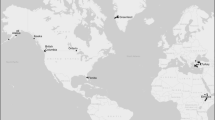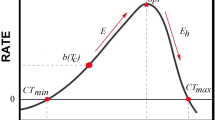Abstract
Annual growth rates of Antarctic marine organisms are low compared to their relatives from warmer waters. Previous studies hypothesise that high food availability during austral spring–summer may enable Antarctic invertebrates to attain comparatively high short-term growth rates despite the low temperature. Neither a temperature-growth experiment with juvenile Adamussium colbecki (Smith 1902) nor the comparison of A. colbecki summer growth rates with an empirical scallop specific growth-to-temperature relationship could confirm this hypothesis. Hence, summer growth rates of young, immature A. colbecki are strongly affected by temperature, i.e. no “uncoupling” from temperature.


Similar content being viewed by others
References
Ahn IY, Surh J, Park YG, Kwon H, Choi KS, Kang SH, Choi HJ, Kim KW, Chung H (2003) Growth and seasonal energetics of the Antarctic bivalve Laternula elliptica from King George Island, Antarctica. Mar Ecol Prog Ser 257:99–110
Arendt J (1997) Adaptive intrinsic growth rates: an integration across taxa. Q Rev Biol 72:149–177
Arntz WE, Brey T, Gallardo VA (1994) Antarctic zoobenthos. Oceanogr Mar Biol Ann Rev 32:241–304
Barnes DKA (1995) Seasonal and annual growth in erect species of Antarctic bryozoans. J Exp Mar Biol Ecol 188:181–198
Berkman PA (1990) The population biology of the Antarctic scallop, Adamussium colbecki (Smith 1902) at New Harbor, Ross Sea. In: Kerry KR, Hempel G (eds) Antarctic ecosystems: ecological change and conservation. Springer, Berlin Heidelberg, New York, pp 281–288
Brey T, Clarke A (1993) Population dynamics of marine benthic invertebrates in Antarctic and subantarctic environments: are there unique adaptations. Ant Sci 5:253–266
Brey T, Hain S (1992) Growth, reproduction and production of Lissarca notorcadensis (Bivalvia: Philobryidae) in the Weddell Sea, Antarctica. Mar Ecol Prog Ser 82:219–226
Brockington S, Clarke A, Chapman ALG (2001) Seasonality of feeding and nutritional status during the austral winter in the Antarctic sea urchin Sterechinus neumayeri. Mar Biol 139:127–138
Cattaneo-Vietti R, Chiantore M, Albertelli G (1997) The population structure and ecology of the Antarctic scallop Adamussium colbecki (Smith, 1902) at Terra Nova Bay (Ross Sea, Antarctica). Sci Mar 61 (Suppl 2):15–24
Chandler RA, Parsons GJ, Dadswell MJ (1989) Upper and northern Bay of Fundy scallop surveys, 1986–1987. Can Tech Rep Fish Aquat Sci 1665:37
Chauvaud L, Strand O (1999) Growth traits in three populations of Pecten maximus. Book of Abstracts: 12th international pectinid workshop, pp 166–167
Chauvaud L, Thouzeau G, Paulet YM (1998) Effects of environmental factors on the daily growth rate of Pecten maximus juveniles in the Bay of Brest (France). J Exp Mar Biol Ecol 227:83–111
Chiantore M, Cattaneo-Vietti R, Albertelli G (2000) The population structure and ecology of the Antarctic Scallop Adamussium colbecki in Terra Nova Bay. In: Faranda FM, Guglielmo L, Ianora A (eds) Ross Sea Ecology: Italiantartide Expeditions (1987–1995). Springer, Berlin Heidelberg New York, pp 563–573
Clarke A (1988) Seasonality in the antarctic marine environment. Comp Biochem Physiol 90B:461–473
Clarke A (1998) Temperature and energetics: an introduction to cold ocean physiology. In: Pörtner HO, Playle R (eds) Cold ocean physiology. University Press, Cambridge, pp 3–30
Clarke A (2003) Costs and consequences of evolutionary temperature adaptation. Trends Ecol Evol 18:573–581
Clarke A, Prothero-Thomas E, Beaumont JC, Chapman AL, Brey T (2004) Growth in the limpet Nacella concinna from contrasting sites in Antarctica. Polar Biol 28:62–71
Conover DG, Schultz ET (1995) Phenotypic similarity and the evolutionary significance of countergradient variation. Trends Ecol Evol 10:248–252
Dadswell MJ (1989) Potential for giant scallop (Placopecten magellanicus) aquaculture in Atlantic Canada. Aquacult Assoc Can Bull 89:19–22
Dadswell MJ, Parsons GJ (1991) Potential for aquaculture of sea scallop, Placopecten magellanicus (Gmelin, 1791) in the Canadian Maritimes using naturally produced spat. In: Shumway SE, Sandifer PA (eds) An international compendium of scallop biology and culture World aquaculture workshops. The World Aquaculture Society, Baton Rouge LA, pp 300–307
Dahm C (1996) Ökologie und Populationsdynamik antarktischer Ophiuroiden (Echinodermata). Ber Polarforsch 194:1–289
Harrington RJ (1987) Skeletal growth histories of Protothaca staminea (Conrad) and Protothaca grata (Say) throughout their geographic ranges, northeastern Pacific. Veliger 30:148–158
Heilmayer O, Brey T, Chiantore M, Cattaneo-Vietti R, Arntz WE (2003) Age and productivity of the Antarctic scallop, Adamussium colbecki, in Terra Nova Bay (Ross Sea, Antarctica). J Exp Mar Biol Ecol 288:239–256
Heilmayer O, Brey T, Pörtner HO (2004) Growth efficiency and temperature in scallops: a comparative analysis of species adapted to different temperatures. Funct Ecol 18:641–647
Kaehler S, McQuaid CD (1999) Use of the fluorochrome calcein as an in situ growth marker in the brown mussel Perna perna. Mar Biol 133:455–460
Levinton JS, Monahan RK (1983) The latitudinal compensation hypothesis: growth data and a model of latitudinal growth differentiation based upon energy budgets. II. Intraspecific comparisons between subspecies of Ophryotrocha puerilis (Polychaeta: Dorvilleidae). Biol Bull 165:699–707
Lonsdale DJ, Levinton JS (1985) Latitudinal differentiation in copepod growth: an adaptation to temperature. Ecology 66:1397–1407
MacDonald BA, Thompson RJ (1988) Intraspecific variation in growth and reproduction in latitudinally differentiated populations of the giant scallop Placopecten magellanicus (Gmelin). Biol Bull 175:361–371
Maru K (1985) Ecological studies on the seed production of scallop, Patinopecten yessoensis (Jay). Sci Rep Hokk Fish Exp Stud 27:1–55
Mohler JW (1997) Immersion of larval Atlantic salmon in calcein solutions to induce a non-lethally detectable mark. N Am J Fish Mgmt 17:751–756
Moran AL (2000) Calcein as a marker in experimental studies newly-hatched gastropods. Mar Biol 137:893–898
Nolan CP, Clarke A (1993) Growth in the bivalve Yoldia eightsi at Signy Island, Antarctica, determined from internal shell increments and calcium-45 incorporation. Mar Biol 117:243–250
Parsons KE (1997) Contrasting patterns of heritable geographic variation in shell morphology and growth potential in the marine gastropod Bembicium vittatum: evidence from field experiments. Evolution 51:784–796
Parsons GJ, Robinson SMC, Roff JC, Dadswell MJ (1993) Daily growth rates as indicated by valve ridges in postlarval giant scallop (Placopecten magellanicus) (Bivalvia: Pectinidae). Can J Fish Aquat Sci 50:456–464
Peck LS (2002) Ecophysiology of Antarctic marine ectotherms: limits to life. Polar Biol 25:31–40
Peck LS, Colman JG, Murray AWA (2000) Growth and tissue mass cycles in the infaunal bivalve Yoldia eightsi at Signy Island, Antarctica. Polar Biol 23:420–428
Ruiz-Verdugo CA, Cáceres-Martinez C (1991) Experimental spat collection of scallops Argopecten circularis (Sowerby, 1835), and Pecten vogdesi (Arnold, 1906) on a filament substrate in Falsa Bay, B.C.S. Mexico. In: Shumway SE, Sandifer PA (eds) An international compendium of scallop biology and culture World aquaculture workshops. The World of Aquaculture Society, Baton Rouge, pp 21–27
Schultz ET, Lankford TE, Conover DO (2002) The covariance of routine and compensatory juvenile growth rates over a seasonality gradient in a coastal fish. Oecologia 133:501–509
Sukhotin AA, Abele D, Pörtner HO (2002) Growth, metabolism and lipid peroxidation in Mytilus edulis: age and size effects. Mar Ecol Prog Ser 226:223–234
Thorarinsdôttir GG (1994) The Iceland scallop, Chlamys islandica (O.F. Müller), in Breidafjordur, west Iceland. III. Growth in suspended culture. Aquacult 120:295–303
Thouzeau G, Robert G, Smith SJ (1991) Spatial variability in distribution and growth of juvenile and adult sea scallop Placopecten magellanicus (Gmelin) on eastern Georges Bank (Northwest Atlantic). Mar Ecol Prog Ser 74:205–218
Yoshida T, Toda T, Hirano Y, Matsuda T, Kawaguchi S (2004) Effect of temperature on embryo development time and hatching success of the Antarctic krill Euphausia superba dana in the laboratory. Mar Fresh Behav Physiol 37:137–145
Acknowledgements
We thank the members of the Italian Antarctic Research station ‘Terra Nova Bay’, especially the ‘Malippo’-Crew and the divers for sampling of animals. Daniela Storch (AWI) helped during several aspects of the study. This research has been carried out—thanks to the support of the Italian National Program for Antarctic Research (PNRA) and the Alfred Wegener Institute for Polar and Marine Research (AWI). The manuscript benefited greatly from the comments of Andrew Clarke (British Antarctic Survey), Alex Sukhotin (White Sea Biological Station) and an anonymous reviewer.
Author information
Authors and Affiliations
Corresponding author
Appendix
Appendix
Rights and permissions
About this article
Cite this article
Heilmayer, O., Honnen, C., Jacob, U. et al. Temperature effects on summer growth rates in the Antarctic scallop, Adamussium colbecki. Polar Biol 28, 523–527 (2005). https://doi.org/10.1007/s00300-005-0716-7
Received:
Revised:
Accepted:
Published:
Issue Date:
DOI: https://doi.org/10.1007/s00300-005-0716-7




